The following essay by John Smatlak has been adapted from the introduction on the Homepage of the Vintage Trolley website.
What is a vintage trolley?
A vintage or heritage trolley (streetcar) is a regularly-scheduled public transportation mode
using genuine historic or replica electric railway cars in an urban environment,
which is operated independently from an established railway or trolley museum.
The cars run on rails and operate electrically from overhead wires (or sometimes a mobile generator).
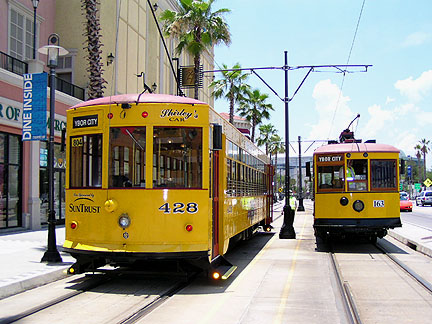 Tampa's TECO vintage streetcar system is a superb example of how a vintage trolley can contribute to the revitalization of the central area of an American city.
Tampa's TECO vintage streetcar system is a superb example of how a vintage trolley can contribute to the revitalization of the central area of an American city.
[Photo: John Smatlak]
Vintage trolleys are part of the ongoing renaissance which is bringing new life to America's urban centers.
As more and more Americans return to the city, the need for new urban transportation solutions grows ever more important.
Transportation is the key to creating great public places – and cities across the country are taking a new look at an old idea, the city streetcar.
Whether applied in the form of a vintage trolley or a modern streetcar, the goal of helping build livable communities remains the same.
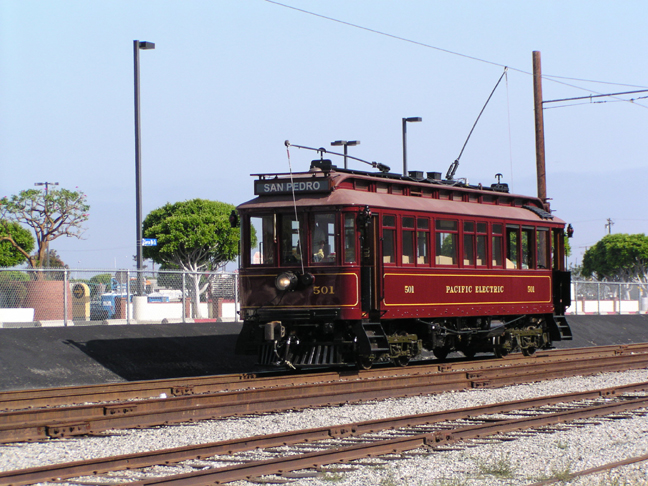 Vintage trolleys provide an authentic historic trolley experience that mixes urban transportation with visitor entertainment.
The ratio of this mixture varies widely; on some systems the trolleys are operated as part of the local transit system and provide a full-fledged transportation function.
Other operations are quite small, and are primarily operated as a tourist attraction, often by a local non-profit.
Vintage trolleys provide an authentic historic trolley experience that mixes urban transportation with visitor entertainment.
The ratio of this mixture varies widely; on some systems the trolleys are operated as part of the local transit system and provide a full-fledged transportation function.
Other operations are quite small, and are primarily operated as a tourist attraction, often by a local non-profit.
[Photo of San Pedro trolley: John Smatlak]
Why are trolley/streetcar systems being built?
While each system is different, the development of a trolley/streetcar operation
is usually driven by the need to provide attractive short-trip urban circulation,
while facilitating economic development.
A trolley/streetcar is a proven way to attract "choice" riders (riders who have
ready access to a car and are not transit-dependent), a significant advantage over rubber-tired alternatives.
By connecting together activity centers, parking, and other forms of transit with convenient service levels, the line can become the key to creating a vibrant
cityscape that is attractive to residents and retailers alike.
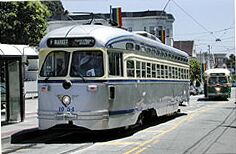 With a well-chosen route, both vintage trolley and modern streetcar systems
have an excellent track record of being a catalyst for change and helping communities maximize public/private investment.
This is due in part to the fixed nature of the rail infrastructure, which implies permanence – it's going to be there for a long time.
The rail system is also highly visible, with an easily understood route, and the
quiet, pollution-free electric trolleys blend in well with the community.
With a well-chosen route, both vintage trolley and modern streetcar systems
have an excellent track record of being a catalyst for change and helping communities maximize public/private investment.
This is due in part to the fixed nature of the rail infrastructure, which implies permanence – it's going to be there for a long time.
The rail system is also highly visible, with an easily understood route, and the
quiet, pollution-free electric trolleys blend in well with the community.
[Photo of San Francisco PCC streetcars: LRN file]
Vintage trolley systems in particular are also much less expensive to build and
operate than conventional rail systems. Infrastructure is simpler, consistent with the trolley's lower speeds and circulator function.
Because it is easily integrated into the built urban environment, the vintage trolley costs significantly less per
mile than higher-capacity, longer-distance modern light rail systems.
Both have their roles to play in the public transit arena of course, and some cities are using
vintage trolley as a precursor to a new light rail system, offering a low-cost
"demonstrator" line that can later be extended or incorporated into a larger system.
Replica trolley cars
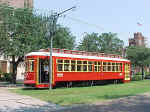 One of the most exciting aspects of today's vintage trolley systems are the
replica trolley cars being offered by companies such as the Gomaco Trolley Company of ida Grove, iowa.
Replica cars have also been produced in-house; the New Orleans Regional Transportation Authority (RTA) partnered with supplier Brookville Equipment and built 23 of its own cars in 2002.
Other cities, such as Philadelphia, opted for a total rebuilds of vintage PCC-type
streetcars (in this case 18 cars by Brookville Equipment), applying new running gear and control equipment to create an almost new car.
Costs for a replica trolley from Gomaco currently (2007) range around $870,000 for an air-conditioned double-truck car (using rebuilt vintage running gear and modern control equipment).
A typical diesel transit bus costs about half as much, but has a shorter service life (12-17 years vs. 25-30 for trolley/streetcar or larger light rail car).
A modern light rail vehicle or modern streetcar costs from $3 to $3.5 million.
One of the most exciting aspects of today's vintage trolley systems are the
replica trolley cars being offered by companies such as the Gomaco Trolley Company of ida Grove, iowa.
Replica cars have also been produced in-house; the New Orleans Regional Transportation Authority (RTA) partnered with supplier Brookville Equipment and built 23 of its own cars in 2002.
Other cities, such as Philadelphia, opted for a total rebuilds of vintage PCC-type
streetcars (in this case 18 cars by Brookville Equipment), applying new running gear and control equipment to create an almost new car.
Costs for a replica trolley from Gomaco currently (2007) range around $870,000 for an air-conditioned double-truck car (using rebuilt vintage running gear and modern control equipment).
A typical diesel transit bus costs about half as much, but has a shorter service life (12-17 years vs. 25-30 for trolley/streetcar or larger light rail car).
A modern light rail vehicle or modern streetcar costs from $3 to $3.5 million.
[Photo of New Orleans RTA/Brookville streetcar: Saminco]
The Replica Trolley Cars webpage
provides a complete roster of all replica cars built to date, with facts and figures (including cost) on each.
|
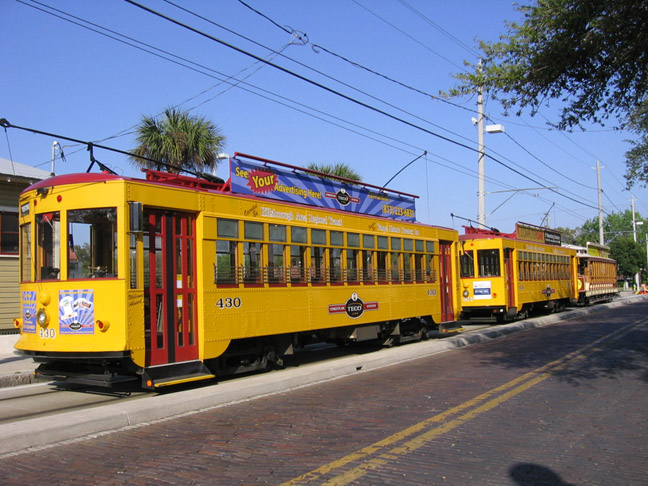
Gomaco replica vintage car Capacity: 88 passengers;
44 seated, 44 standing
|
How are vintage trolleys different from Modern Streetcars?
Both the vintage trolley and the modern streetcar utilize essentially the same infrastructure.
Both can be easily integrated into the built urban environment using relatively low-impact construction techniques.
Both vintage and modern cars can be air conditioned, and both can provide a comfortable ride given the short trip times involved.
There are differences in the vehicles to be sure; modern streetcars can achieve level boarding with relative ease, and of course they provide the ultra-modern appearance which may be desirable depending on other project elements.
it should also be noted that some cities (such as Portland) have operated both types of cars on the same route.
There are also significant differences in vehicle cost and complexity, a modern replica vintage car selling from about $870,000
and a modern articulated streetcar at around $3 million (the vehicle is also larger – see photos at left).
The replica vintage cars are also readily available and US-built, avoiding the Buy America issues that are currently confronting agencies
buying the present generation of off-the-shelf vehicle from Inekon
in the Czech Republic (plans are also underway to begin building such vehicles in the US; this development is described in the following article:
Oregon Company to be Awarded Federal Contractor for First U.S.-Made Modern Streetcar
in the end, a host of local factors will play into the decision of which vehicle type should be used, but both can provide effective urban circulation that is attractive to riders.
|
|
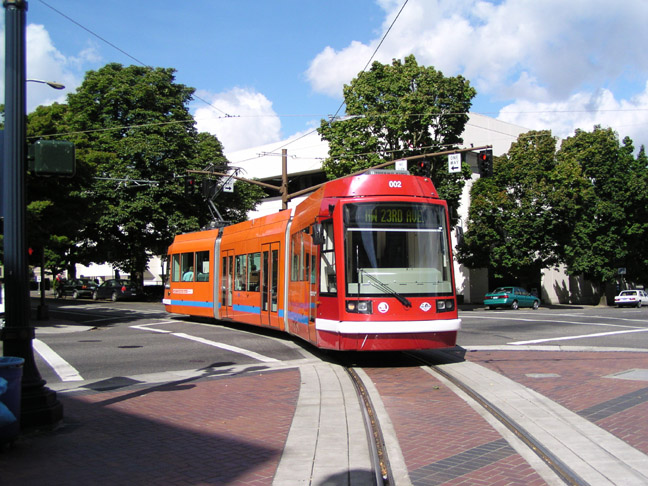
inekon/Skoda modern articulated streetcar
Capacity: 157 passengers;
30 seated, 127 standing
|
More information on vintage trolleys and streetcars
For more background information on vintage trolleys, here are some suggestions:
· Check out the Heritage Streetcars Focus Topic section of this website Light Rail Now.
· APTA's Streetcar and Heritage Trolley Website provides an excellent source of information and news on current developments.
· The May 2001 issue of Railway Age had an excellent article on vintage trolleys.
· For a more in-depth look at modern streetcars and vintage trolleys in the context of urban planning,
consult "Bring Back the Streetcars, A Conservative Vision of Tomorrow's Transportation" by Paul Weyrich and William Lind, available in pdf format on the
National Alliance of Public Transportation Advocates website.
· Also, Reconnecting America has published a new book entitled Street Smart: Streetcars and Cities in the 21st Century, available via their website.
Visit the Vintage Trolley Web Site!
And for additional information on the advantages of vintage/heritage strretcars and trolleys, be sure to check out the Vintage Trolley Web Site!
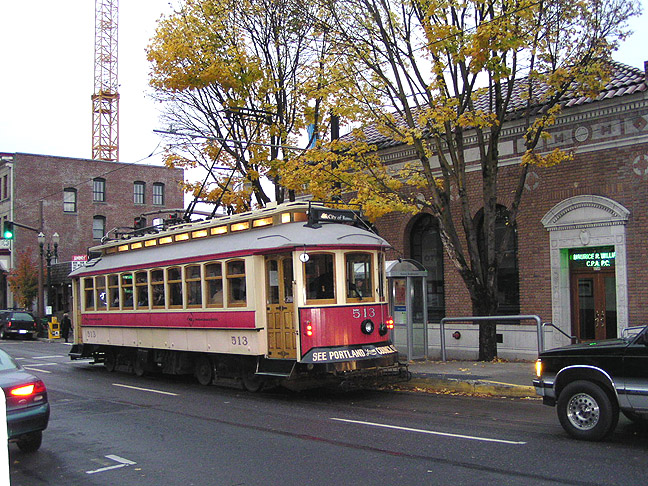 This site provides an overview of US vintage trolley (heritage trolley) operations.
From these pages you can visit the impressive variety of systems now in regular operation and learn about proposals for new systems.
Each page links to websites covering the individual systems and new information is being added continuously, so check back regularly. Contributions are always welcome.
This site provides an overview of US vintage trolley (heritage trolley) operations.
From these pages you can visit the impressive variety of systems now in regular operation and learn about proposals for new systems.
Each page links to websites covering the individual systems and new information is being added continuously, so check back regularly. Contributions are always welcome.
[Photo of Portland vintage trolley: John Smatlak]
Light Rail Now! website
URL: http://www.lightrailnow.org/features/f_lrt_2007-03a.htm
Updated 2007/03/22
More on Rail Transit Development...
More on Heritage Streetcar Systems...
 Tampa streetcars
Tampa streetcars